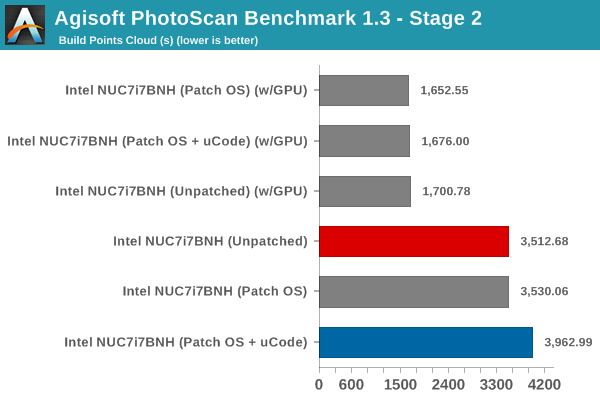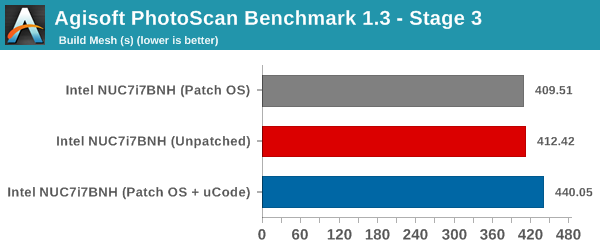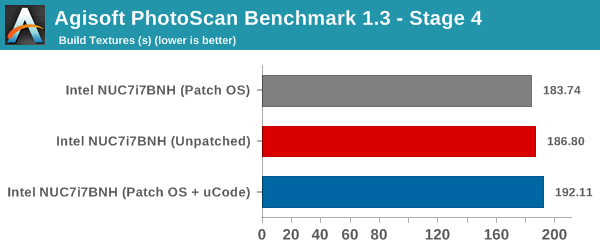Meltdown & Spectre: Analyzing Performance Impacts on Intel's NUC7i7BNH
by Ganesh T S on March 23, 2018 4:15 PM EST- Posted in
- Systems
- Spectre
- Benchmarks
- Meltdown
Miscellaneous Benchmarks
CINEBENCH R15 is our benchmark of choice for 3D rendering. It provides three benchmark modes - OpenGL, single threaded and multi-threaded. This benchmark is largely unaffected by the patching. All the recorded numbers are within the margin of expected errors from one run to another.



x264 v5.0 is another benchmark that is unaffected by the Meltdown and Spectre patches.


7-Zip is a very effective and efficient compression program, often beating out OpenCL accelerated commercial programs in benchmarks even while using just the CPU power. 7-Zip has a benchmarking program that provides tons of details regarding the underlying CPU's efficiency. In our benchmark suite, we are interested in the compression and decompression MIPS ratings when utilizing all the available threads. This benchmark also remains unaffected, with the results happening to be within the margin of error from run to run.


Agisoft PhotoScan is a commercial program that converts 2D images into 3D point maps, meshes and textures. The program designers sent us a command line version in order to evaluate the efficiency of various systems that go under our review scanner. The command line version has two benchmark modes, one using the CPU and the other using both the CPU and GPU (via OpenCL). We have been using an old version of the program with 50 photographs in our reviews till now. The updated benchmark (v1.3) now takes around 84 photographs and does four stages of computation:
- Stage 1: Align Photographs (capable of OpenCL acceleration)
- Stage 2: Build Point Cloud (capable of OpenCL acceleration)
- Stage 3: Build Mesh
- Stage 4: Build Textures
We record the time taken for each stage. Since various elements of the software are single threaded, others multithreaded, and some use GPUs, it is a very relevant benchmark from a media editing and content creation perspective.




Since this is a real-world benchmark, we can see performance impacts in some of the stages. While the first and last ones do not have any significant deviation, stages 2 and 3 are worse off by around 12.8% and 6.8% respectively in the non-GPU case.
The benchmarks section wraps up with the new Dolphin Emulator (v5) benchmark mode results. This is again a test of the CPU capabilities, but, we don't see much impact on the performance from the patching. The bennchmark consistently took around 325 seconds in all three patching configurations.










83 Comments
View All Comments
iter - Monday, March 26, 2018 - link
According to whom? You, the workstation all-seer? Or perhaps some statistics done over the internet?iter - Monday, March 26, 2018 - link
Also, if a "standalone system" is for you the opposite of "connected to the internet" that is quite indicative... You know there exists this thing called a network, on top of which the internet runs. You can have a load of workstations and servers in a network that is not connected to the outside world.Most places that do important work do it this way. Eliminates 99.99% of threats from the outside and the from the inside. Just one of many other common sense things, such as disabled usb storage devices, unauthorized network clients and whatnot. Machines that do connect to the internet are physically isolated from the secure network. They use secure proprietary interfaces for explicit data transfer between the two networks under tight scrutiny.
rhoades-brown - Tuesday, March 27, 2018 - link
Eh? So, your saying that you would put your workstations unpatched and completely unprotected on a network where other devices can connect to it?Did you hear about WannaCrypt? Your network connected workstation would have been easy prey.
Would you allow these unprotected workstations to share files with other workstations and what about the cheaper machines? I assume that you are either creating or processing content/data of some description. Have a look at MS16-120 - 'The most serious of these vulnerabilities could allow remote code execution if a user either visits a specially crafted website or opens a specially crafted document.'
What about USB sticks? Something on one machine could easily be spread to another, and people are stupid enough to plug in a USB stick that they found in a car park, etc.
There are exceptions- air-gaped networks to make things highly secure, but that seems unlikely, and if your workstations are in that rare scenario, have a look at xLED which uses a compromised switch to flash it's status LEDs to share data- crazy, I know; scary, absolutely.
Gasaraki88 - Monday, March 26, 2018 - link
Wow, that's a big exaggeration...Bulat Ziganshin - Friday, March 23, 2018 - link
>Though there is a certain irony to the fact that taken to its logical conclusion, patching a CPU instead renders storage performance slower, with the most impacted systems having the fastest storage.It looks ironic because it was incorrectly attributed as CPU bug. But the point is that it allows to discover information when OS allows it, and thus it's an OS bug of not preventing it. As far as you run pure CPU computations, it doesn't need any mitigations.
The only thing that need to be patched is communication between OS and application, and therefore you got larger hit when these communications are more intensive - on higher-IOPS operations. So f.e. I/O in large blocks (1 MB or so) is unaffected, but 4K I/O is affected, especially with higher-performance drives and higher QD scenarios.
jordanclock - Friday, March 23, 2018 - link
It is a CPU bug. The speculative execution is faulty and that is a CPU feature. The OS patches are simply workarounds to prevent certain kinds of speculative execution.Reflex - Friday, March 23, 2018 - link
It is not a bug at all at either level. It is a feature that was found to be able to be abused. That happens all the time. Once found, it was mitigated, in this case by disabling the feature (Meltdown) or mitigating the impact (Spectre). In future designs it will be mitigated or eliminated.There are all sorts of features your CPU is capable of utilizing that can compromise your data or stability (hey, you can still run in unprotected mode for memory!), when it is found to be a problem it is typically disabled at the appropriate level (microcode/firmware/OS).
bji - Friday, March 23, 2018 - link
Uh, no. It's a feature that comes with an unintended side effect of allowing data reads that should be disallowed. That part of it is a bug, plain and simple. I guess you are the kind of person that would call a bug that crashes the computer a "feature" because "it saves you power when your PC is off because it crashed".PixyMisa - Friday, March 23, 2018 - link
So it's a bug.yeeeeman - Saturday, March 24, 2018 - link
Bug is something that doesn't work as designed. I am pretty sure that they designed and verified it this way. These vulnerabilities are not bugs, they are just security loopholes.